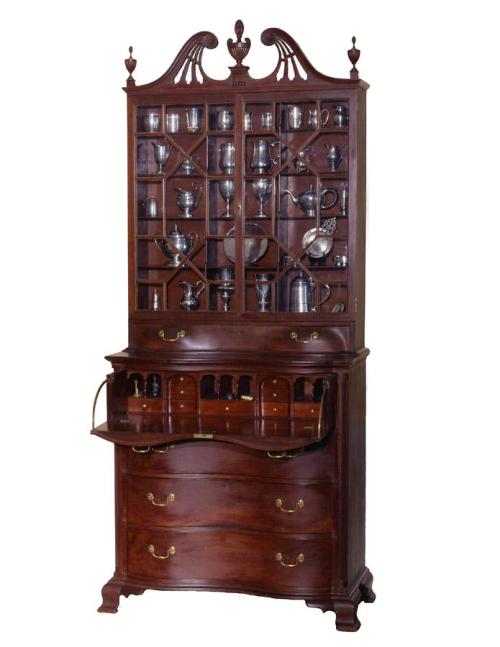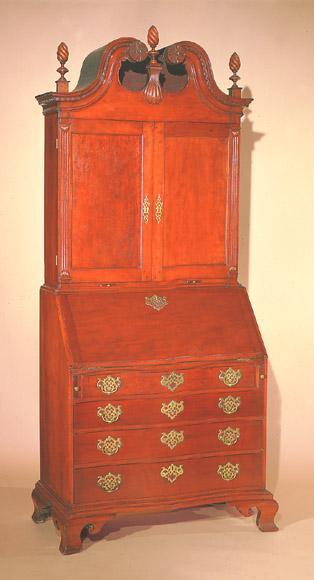Desk and Bookcase
Furniture MakerAttributed to the shop of
Eliphalet Chapin
(American, 1741 - 1807)
Original OwnerProbably originally owned by
John Watson
(1744 - 1824)
Date1786-1790
MediumCherry primary wood, white pine and maple secondary wood, glass, brass hardware
DimensionsPrimary Dimensions (overall height): 102 3/4in. (261cm)
Upper Case (height x width x depth): 56 3/4 x 41 3/4 x 3/4in. (144.1 x 106 x 1.9cm)
Lower Case (height x width x depth): 46 x 42 1/8 x 18 1/2in. (116.8 x 107 x 47cm)
ClassificationsFurniture
Credit LineGift of Dr. and Mrs. Thomas P. Kugelman
Object number2012.324.1
DescriptionScroll-top desk and bookcase. Bookcase has English-style glazed panels with overlapping mitred doors (vertically slanted inner edge), above a narrow bosom drawer. The oxbow lower case has four equivalent size drawers, the top drawer a pullout butler's, or secretary drawer, which pivots forward to reveal the interior. The interior includes drawers and pigeonholes with a double-blocked drawer on the left side. The "balls" pediment features small, carved spheres integrated into carrot-shaped openings. The urn-shaped finials are original; the carved rosettes are appropriate but are later restorations.
Design and Construction Details:
Quarter columns are assembled from three pieces: a turned capital and base with a fluted column in between. The flutes extend into the capital and base with a clearly visible seam where they are joined.
Backboards are slid into grooves in the case sides and top or bottom.
“Quadrant base” construction of the base. The front ogee feet are joined together at the corners with concealed dovetails (invisible from the outside) and mounted on a large quarter-round horizontal block (quadrant) that is nailed to a 3-sided frame which incorporates the base molding. This frame, in turn, is nailed to the case bottom. The rear feet are supported by a right angle brace with exposed vertical dovetails, visible from the rear, and similarly mounted on a quadrant block. The feet splay (angle outward) by approximately 7°.
Condition: There are various repairs and signs of wear, but, except for the restored upper half of the pediment, the piece is essentially intact. The brasses are replaced but stylistically correct.
Please see attached essay by the Chapin authority, Dr. Thomas P. Kugelman for more information about this piece.
Design and Construction Details:
Quarter columns are assembled from three pieces: a turned capital and base with a fluted column in between. The flutes extend into the capital and base with a clearly visible seam where they are joined.
Backboards are slid into grooves in the case sides and top or bottom.
“Quadrant base” construction of the base. The front ogee feet are joined together at the corners with concealed dovetails (invisible from the outside) and mounted on a large quarter-round horizontal block (quadrant) that is nailed to a 3-sided frame which incorporates the base molding. This frame, in turn, is nailed to the case bottom. The rear feet are supported by a right angle brace with exposed vertical dovetails, visible from the rear, and similarly mounted on a quadrant block. The feet splay (angle outward) by approximately 7°.
Condition: There are various repairs and signs of wear, but, except for the restored upper half of the pediment, the piece is essentially intact. The brasses are replaced but stylistically correct.
Please see attached essay by the Chapin authority, Dr. Thomas P. Kugelman for more information about this piece.
Label TextThe formula of construction practices in case furniture maintained by the Eliphalet Chapin shop is evident in this piece, as are neo-classical design changes that occurred after 1780. This cherry scroll-top desk and bookcase can be placed and dated precisely because it is signed by three apprentices or journeymen who were together in the East Windsor shop of Eliphalet Chapin only during the years 1786-90. It is the largest and most elaborate of four similar desks and bookcases that feature English-style glazed bookcase doors above a shallow swelled “bosom” drawer and a pullout “butler’s” desk drawer in the lower case.
NotesInscription Note: "WF" incised on back part of lower-case top (under bookcase). This is William Flagg (1772-1859) who would have started his apprenticeship in the Chapin shop no earlier than 1786. He advertised as a cabinetmaker in Hartford in 1796 and later worked for a time in Providence (listed in 1826 Providence city directory). His full name and/or initials are inscribed on several other Chapin-associated objects. "Julius Barnard" in graphite on inside of third long drawer bottom. This is Julius Barnard (1769-after 1812), a Northampton native who returned to work there, making Chapin school furniture for family members, before migrating to Windsor, Vermont (1805-1807 ads) and, finally, to Montréal.
"P. Israel" in graphite on inside of lower-case backboard. This is probably Israel Porter (1759-after 1830, no other names match), at his age probably working as a journeyman. By 1790 he had his own shop in Wethersfield and, after 1800, moved to Middletown.
Object Note: Please see attached essay by the Chapin authority, Dr. Thomas P. Kugelman for more information about this piece.
Status
Not on view









